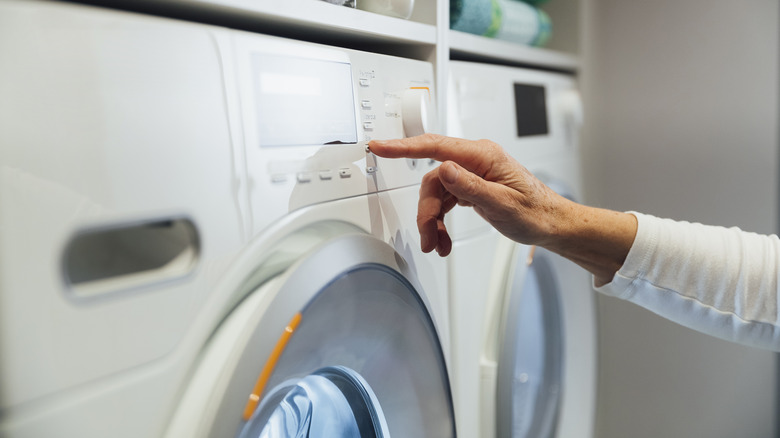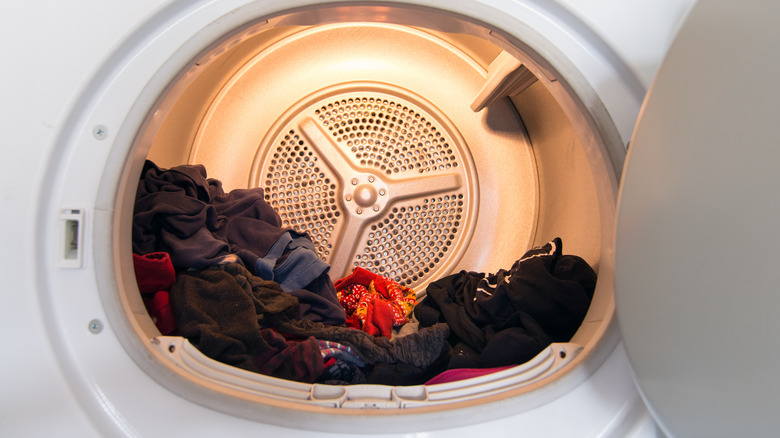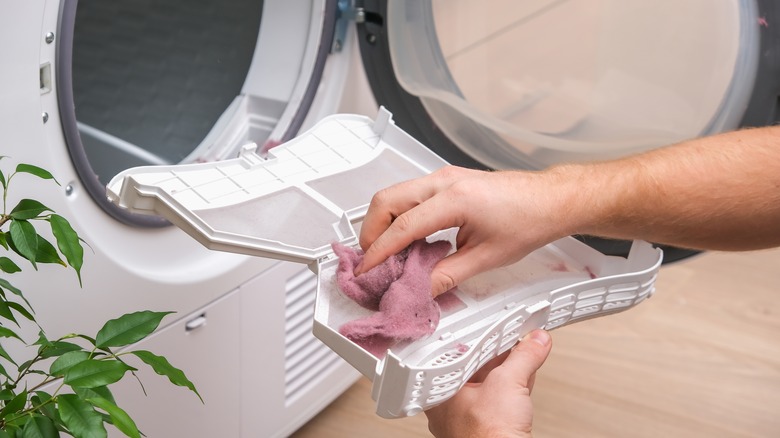Why It Might Be A Bad Thing If Your Dryer's Auto-Shutoff Kicks On
If you've ever thrown a wet load of laundry into your dryer only to discover the appliance turned off a few minutes later, then you know just how frustrating that scenario could be. Rather than pressing a button and considering the task done, you need to remove the soggy laundry and pin each article of clothing to a line or drape it over a drying rack. To avoid that extra work, you might try to diagnose the issue. First, you can check the plug to see if it's firmly in the outlet. Then, check the lint trap to make sure it's been cleared. Also check the amount of laundry you put into the appliance, and make sure it's no more than usual. If your dryer continues to turn off every few minutes, it could be that its auto-shutoff feature is kicking on. And if that safety feature is being triggered, it could mean your appliance is overheating and posing a fire hazard.
While you don't have to panic just yet, it should be a cause for concern and inspire immediate action. While your lint trap might be clear, the dryer vents could be clogged with residual lint, obstructing the air from leaving your appliance. Because of that, it's overheating and causing the auto-shutoff feature to switch on. To get it to stop, you will need to clean out the vent system. Here is a closer look at why the auto-shutoff is being activated and how to stop it.
Why the auto-shutoff feature kicking in is a bad thing
Lint is the hidden danger lurking in your dryer vents, and it could very well be the cause of why your dryer is overheating. When the vent system gets clogged with built-up lint, one of two things can happen: First, the appliance has to work harder to push the hot air out. Because of this, the motor becomes strained and begins to overheat. Second, the lint is obstructing the exhaust vent, blocking the hot air from leaving. This causes a buildup of heat, making the temperature rise. When the dryer feels hot to the touch, the trapped lint could ignite. Because of this, the safety feature gets tripped, indicating you might be dangerously close to starting a fire.
The auto-shutoff feature activates in two ways — via the high-limit thermostat and the thermal fuse. When the dryer's high-limit thermostat reaches a dangerous temperature, the auto-shutoff activates, turning off the machine's power. The appliance may only turn back on when the temperature falls back down to safe levels. However, if the temperature continues to climb and surpasses what the thermostat can read, the second safety feature will trigger, which is the thermal fuse. When this is activated, it means your appliance is reaching dangerous temps and is at risk of a fire. To protect you, the device blows, cutting all power to the machine. To turn the dryer back on, you will need to buy a replacement fuse.
How to prevent it from triggering
To prevent the auto-shutoff from triggering, you need to ensure the dryer has a way to expel its hot air. The remedy is to clean your dryer. The first thing to check is your lint trap. Ensure you're always removing lint before turning on the appliance. If the lint trap is clear, take a closer look and see if there is any waxy residue on it, especially if you use dryer sheets. The sheets' coating can cover the trap's mesh, making it difficult for heat to pass through. You'll know if the lint screen is clogged with residue if you drip a few water droplets on it. If the water beads on top, it's blocked. Simply wash it with dish soap or vinegar, and allow it to fully dry before putting it back into the appliance.
If the lint screen isn't the culprit, then it's time to clean the exhaust vent. First, go outside and check that the duct's backdraft damper isn't clogged. This is a valve that keeps backdrafts, rodents, and debris from entering your venting system from the outside. If that's clear, check the vent hose that attaches your dryer to the wall. Unplug the machine, remove the hose, and use a vacuum to clear it of debris. Then, go outside and do the same to the exterior dryer vent.


